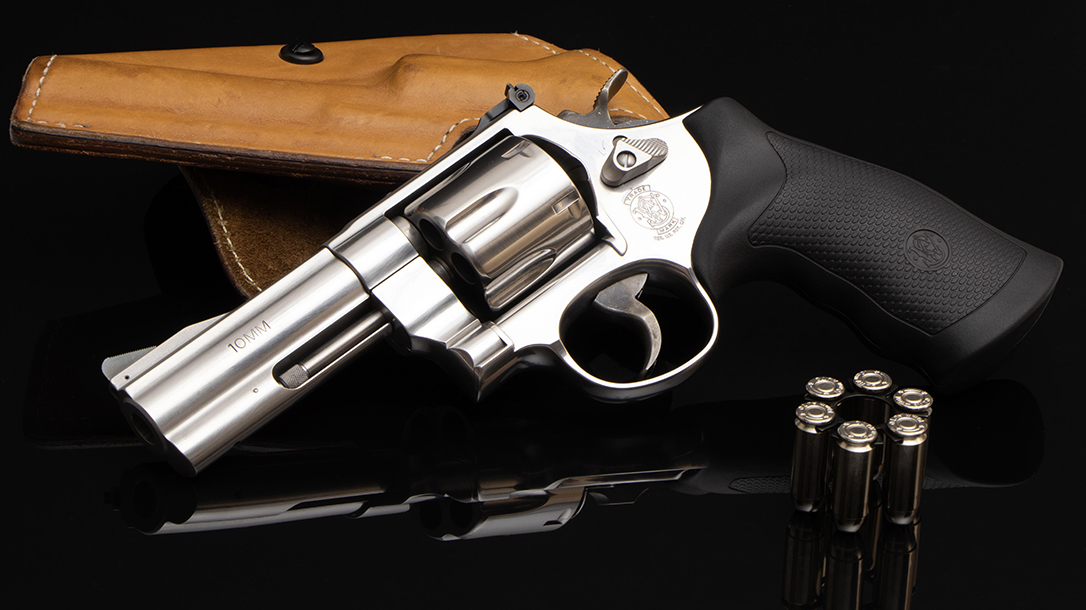A droplet of sweat rolled into my right eye, stinging it and causing a brief moment of distraction. In my ears, I could only hear my breathing, heavy and deep. My front sight was impossibly still while covering the chest of the two-time convicted felon. I was screaming something at him, telling him to drop his weapon. My voice seemed so far away, but the voice inside my head was thunderous, shouting warnings at me.
At a time like this, precious moments can’t be wasted worrying about what kind of gun you purchased, or if the ammunition you selected is adequate. Dealing with the threat is more than enough challenge to keep you busy. However, having the right tools will help keep your mind focused on the immediate danger.
Advertisement — Continue Reading Below
There are many options available to you for home defense. Flip through this magazine and you’ll see many excellent products from which to choose. None of these will work for all people in all circumstances. You have to choose the best products for your needs and circumstances, and then train with those tools to achieve a high degree of competency.
Time Tested
Historically speaking, few firearm types have served American citizens as well for self-defense as the double-action (DA) revolver. By and large, these guns are reliable and durable and employ a variety of very potent cartridges.
Perhaps the best-known revolver-maker is Smith & Wesson. With names like Combat Magnum, the wheelguns from S&W proved their effectiveness in the trenches around Verdun, in the holsters of beat cops and in the hands of American citizens protecting families around the nation.
Advertisement — Continue Reading Below
In an era dominated by polymer-framed semi-autos, I believe the classic Smith & Wesson revolver remains a logical choice for self-defense. And the company recently returned an old six-shooter to its lineup: the Smith & Wesson Model 610 in 10mm Auto. Does this revolver make sense for a bedside gun? Let’s take a look.
A Closer Look
Shooting semi-auto pistol rounds in a revolver is one of my admitted weaknesses. To me, there is something quirky enough about the concept to capture my imagination. Although guns chambered for the 9mm and .45 ACP dominate this niche, other examples exist. Of course, the concept of rimless cartridges in wheelguns isn’t new. For example, some U.S. servicemen carried Smith & Wesson revolvers chambered for the .45 ACP during World War I when 1911 pistol production could not meet the surge in demand.
The original Model 610 dates back roughly 30 years. According to the Standard Catalog of Smith & Wesson, the company released the first Model 610 in 1989. Like the modern version, it fed 10mm Auto cartridges from moon clips and would also run the .40 S&W when that cartridge debuted the following year. Smith & Wesson discontinued the 610 in 2005.
Advertisement — Continue Reading Below
For 2019, Smith & Wesson returned the 610 to its lineup. It appears the company is picking up right where it left off. The new gun retains its six-shot cylinder and N-Frame, giving it a heft that immediately communicates durability. The new 610 is available with either a 4- or 6.5-inch barrel. For home-defense purposes, I find the 4-inch version to be the better choice. It is long enough to allow the 10mm rounds to achieve good velocity yet is very well balanced.
By the Numbers
When unloaded, the gun weighs a little more than 2.5 pounds. I find the weight reassuring instead of cumbersome, and for a nightstand gun, the weight is largely irrelevant since you aren’t carrying it. Nevertheless, with a quality gun belt and holster, there is nothing that prevents you from carrying it comfortably. Much of the weight is due to the stainless steel frame, barrel and cylinder, which offer a lifetime of shooting full-power loads.
The Model 610 has a reasonably good DA trigger pull. It feels consistent from shot to shot, with no staging and an even weight throughout the stroke. The DA pull is heavy—maybe 13 to 14 pounds. Unfortunately, the pull exceeded the 12-pound maximum on my scale. I strongly suspect that range time will naturally improve the pull over time. The single-action (SA) pull was light and crisp at an average of 3.81 pounds over 10 pulls. It had no creep and a short range of motion.
Advertisement — Continue Reading Below
Revolvers frequently offer flexibility that bottom feeders cannot provide. In the case of the 610, you can shoot both 10mm and .40 S&W cartridges without a single modification to the gun. Most shooters know you can fire .38 Specials in a .357 Magnum wheelgun, and the 610 works the same way with 10mm and .40 rounds.
One of the beautiful things about the ability to run .40 S&W in these guns is that the shorter ammo tends to be more affordable than 10mm loads. For practice and plinking, I’d much rather pay $11 to $12 per box for .40 S&W loads than $17 to $18 per box for 10mms. It doesn’t take very long for that difference to add up.
Some Backstory
The history of the 10mm Auto is one of the fascinating shooting stories of the 1980s. Initially conceived by the great Jeff Cooper, the 10mm was intended to be the ideal self-defense cartridge. A collaboration with Norma allowed Dornaus & Dixon Enterprises to bring Cooper’s concept to market in 1983. Enter the Bren Ten pistol.
Advertisement — Continue Reading Below
Although the Bren Ten’s popularity was juiced by its weekly appearance in the hands of Detective Sonny Crockett in the wildly popular Miami Vice TV series, the gun was ultimately a failure due to production issues. Colt kept the 10mm alive with the famous Delta Elite pistol, but the most significant boost to the cartridge’s survival probably came from Smith & Wesson.
In the wake of a real-world Miami shootout, the FBI decided the performance of the 9mm cartridge issued to agents was unacceptable. Popular opinion demanded better performance. For a new duty pistol, the agency selected the Smith & Wesson Model 1076 in 10mm.
But, as the story goes, the FBI desired milder 10mm ammunition. During the development process for the FBI’s requirements, S&W engineers speculated that a compact cartridge could meet the FBI’s performance requirements and offer benefits such as increased magazine capacity. From this, the .40 S&W cartridge was born. In relatively short order, the FBI moved to the shorter .40 S&W. Thankfully, the 10mm is still alive and well today due to shooters who appreciate its power.
Advertisement — Continue Reading Below
On The Range
Without reservation, the primary characteristic I want in a defensive firearm is reliability. If a weapon fails to function every time I stroke the trigger, I refuse to use it for protection. In this regard, the S&W Model 610 ticks the box as well as any other firearm I’ve shot. I ran both 10mm and .40 S&W rounds through the revolver, and they all performed as designed.
If you’ve ever heard somebody complain about the challenge of managing recoil from the 10mm, stop listening and make a date with the Model 610. With both 10mm and .40 S&W defensive loads, the revolver was comfortable to shoot with a smooth recoil impulse, moderate muzzle rise and virtually no flash.
Combining the large N-Frame with full-coverage synthetic grips, Smith & Wesson has designed a gun that mitigates much of the recoil. While I enjoy shooting my J-Frames, a .38 Special +P generates significantly more felt recoil in my Model 642 than this gun did with heavier cartridges.
Advertisement — Continue Reading Below
In addition to the self-defense loads listed in the performance table, I ran a bunch of 10mm and .40 S&W FMJs from Remington and Winchester through the gun. These range loads all handled well.
Evaluating Performance
The black blade front sight can be challenging to pick up depending on your lighting conditions. For my money, I would prefer to have one of the classic red ramp inserts Smith & Wesson has used on many of its revolvers. Even so, I was able to achieve respectable groups at 7 to 15 yards, unsupported.
The velocities of the 10mm loads were below the manufacturers’ specifications, but I expected that due to gas escaping from the cylinder gap. Less gas pressure naturally results in less force driving the bullet forward.
Advertisement — Continue Reading Below
The exception was the offering from Liberty Ammunition. That load uses a nickel-plated, 60-grain, copper hollow point rated at 2,400 feet per second (fps). From the Model 610, this load had an average velocity of 2,426 fps and a standard deviation of only 7 fps. Not only did the velocity exceed the manufacturer’s specifications, but it also did this with a high degree of consistency. The load had low recoil as well, presumably due to the light-for-its-caliber bullet.
Ready For Anything
Waking up in the middle of the night to an emergency is a harrowing experience. You need tools that will work without hesitation, be they flashlights, fire extinguishers, phones or firearms.
I’m an unabashed Smith & Wesson revolver fan. I’ve had decades of positive experience with them, and the Smith & Wesson Model 610 extends that track record. When you take one in hand, it is ready for whatever you throw at it. While a rimless cartridge might seem like an unusual choice for a six-shooter, the 10mm Auto is a proven chambering that can stop predators quickly—be they human or beast.
For more information, visit smith-wesson.com.
Smith & Wesson Model 610 Specifications
- Caliber: 10mm Auto
- Barrel: 4 inches
- Overall Length: 9.5 inches
- Overall Weight: 42.6 ounces (empty)
- Grips: Synthetic
- Sights: Blade front, adjustable rear
- Action: DA/SA
- Finish: Stainless
- Overall Capacity: 6
- MSRP: $969
Smith & Wesson Model 610 Performance
10mm Auto: Velocity, Accuracy
- Liberty Ammunition 60 JHP: 2,426, 1.49
- Sig Sauer 180 V-Crown JHP: 1,153, 1.07
- Speer 200 Gold Dot JHP: 994, 1.14
.40 S&W: Velocity, Accuracy
- Hornady 175 Critical Duty: 982, 1.72
- Liberty Ammunition 60 JHP: 2,078, 1.89
- Speer 180 Gold Dot JHP: 980, 1.84
Bullet weight measured in grains, velocity in fps by chronograph and accuracy in inches for best five-shot groups at 7 yards.
This article is from the August-September 2019 issue of Personal Defense World magazine. Grab your copy at OutdoorGroupStore.com. For digital editions, visit Amazon.


























